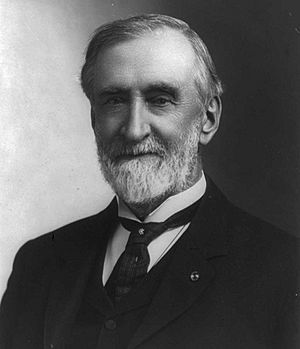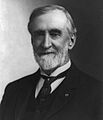Redfield Proctor facts for kids
Quick facts for kids
Redfield Proctor
|
|
|---|---|
 |
|
| United States Senator from Vermont |
|
| In office November 2, 1891 – March 4, 1908 |
|
| Preceded by | George F. Edmunds |
| Succeeded by | John Stewart |
| 37th United States Secretary of War | |
| In office March 5, 1889 – November 5, 1891 |
|
| President | Benjamin Harrison |
| Preceded by | William Endicott |
| Succeeded by | Stephen Elkins |
| 37th Governor of Vermont | |
| In office October 3, 1878 – October 7, 1880 |
|
| Lieutenant | Eben Colton |
| Preceded by | Horace Fairbanks |
| Succeeded by | Roswell Farnham |
| 31st Lieutenant Governor of Vermont | |
| In office October 5, 1876 – October 3, 1878 |
|
| Governor | Horace Fairbanks |
| Preceded by | Lyman G. Hinckley |
| Succeeded by | Eben Colton |
| Personal details | |
| Born | June 1, 1831 Proctorsville, Vermont, U.S. |
| Died | March 4, 1908 (aged 76) Washington, D.C., U.S. |
| Political party | Republican |
| Spouse | Emily Dutton |
| Children | 5, including Fletcher and Redfield |
| Education | Dartmouth College (BA, MA) Albany Law School (LLB) |
| Military service | |
| Allegiance | |
| Branch/service | |
| Years of service | 1861–1863 |
| Rank | |
| Commands | 15th Vermont Infantry |
| Battles/wars | American Civil War |
Redfield Proctor (June 1, 1831 – March 4, 1908) was an important American politician. He was a member of the Republican Party. Proctor held many big jobs. He was the 37th Governor of Vermont from 1878 to 1880. He also served as the Secretary of War from 1889 to 1891. Later, he became a United States Senator for Vermont, serving from 1891 until his death in 1908.
Contents
About Redfield Proctor
Early Life and Education
Redfield Proctor was born on June 1, 1831. He grew up in Proctorsville, Vermont, a village named after his family. His father, Jabez Proctor, was a farmer and a local politician. Redfield's mother, Betsy Parker Proctor, raised him from age 8 after his father passed away.
Proctor was a very smart student. He went to Dartmouth College and graduated in 1851. After college, he returned to Proctorsville to work in business. He later studied law and earned his master's degree from Dartmouth. In 1859, he graduated from Albany Law School. In 1858, he married Emily Jane Dutton. They had five children together.
Serving in the Civil War
When the American Civil War started in 1861, Redfield Proctor joined the army. He returned to Vermont and enlisted in the 3rd Vermont Infantry Regiment. He quickly became a lieutenant. He worked on the staff of General William Farrar Smith.
In October 1862, Proctor was promoted to colonel. He led the 15th Vermont Infantry. His regiment was part of the Gettysburg Campaign. However, they were stationed behind the main battle and did not fight directly. He served in the army until 1863.
Political Career and Business
After the war, Proctor became a lawyer in Rutland (city), Vermont. In 1869, he started working in the marble business. He became a manager at the Sutherland Falls Marble Company. This company later merged with another to form the Vermont Marble Company. Proctor became the president of this large company. In 1886, the area where the marble quarries were located became its own town, named Proctor, Vermont, after him.
Proctor also began his political journey. In 1866, he became a town official in Rutland. The next year, he was elected to the Vermont House of Representatives. He served on important committees. In 1874, he was elected to the Vermont Senate and became its leader.
In 1876, Proctor was elected Lieutenant Governor of Vermont. Two years later, in 1878, he was elected Governor of Vermont. He continued to be active in politics even after his term as governor ended. He attended the Republican National Convention in 1884 and 1888.
Secretary of War
In 1888, the Vermont legislature suggested Proctor for a position in the President's cabinet. In March 1889, President Benjamin Harrison chose Redfield Proctor to be his Secretary of War. This job meant he was in charge of the U.S. Army.
As Secretary of War, Proctor was known for his excellent management skills. He worked hard to modernize the Army. He also improved the living conditions for soldiers. President Harrison praised Proctor's work, noting that he helped reduce the number of soldiers who left the army without permission. This saved money and made the soldiers happier.
United States Senator
Proctor left the War Department in November 1891. He became a United States Senator for Vermont. He filled a spot that became open when Senator George F. Edmunds resigned.
As a Senator, Proctor led several important committees. He was chairman of the Committee on Agriculture and Forestry from 1895 to 1909. He also led the Committee on Military Affairs from 1905 to 1907. He was a strong supporter of high tariffs (taxes on imported goods) and the gold standard. He also influenced military policies during the presidencies of William McKinley and Theodore Roosevelt.
Later Life and Legacy
Redfield Proctor died in Washington, D.C., on March 4, 1908. He is buried in South Street Cemetery in Proctor, Vermont.
His family continued his legacy in Vermont politics. Two of his children, Fletcher D. Proctor and Redfield Proctor, Jr., also served as Governors of Vermont. His grandson, Mortimer R. Proctor, also became governor. His former home in Rutland, the Proctor-Clement House, is now a historic landmark.
Images for kids
See also
 In Spanish: Redfield Proctor para niños
In Spanish: Redfield Proctor para niños



